
Artemisia is a large, diverse genus of plants with between 200 and 400 species belonging to the daisy family Asteraceae. Common names for various species in the genus include mugwort, wormwood, and sagebrush.
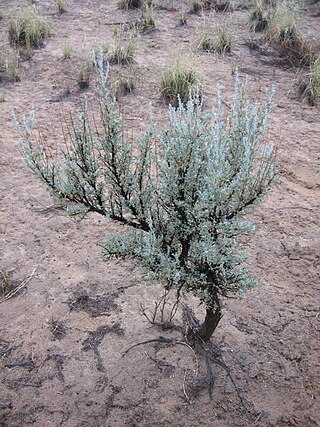
Artemisia tridentata, commonly called big sagebrush, Great Basin sagebrush or (locally) simply sagebrush, is an aromatic shrub from the family Asteraceae, which grows in arid and semi-arid conditions, throughout a range of cold desert, steppe, and mountain habitats in the Intermountain West of North America. The vernacular name "sagebrush" is also used for several related members of the genus Artemisia, such as California sagebrush.

Artemisia abrotanum, the southernwood, lad's love, or southern wormwood, is a species of flowering plant in the sunflower family. It is native to Eurasia and Africa but naturalized in scattered locations in North America. Other common names include: old man, boy's love, oldman wormwood, lover's plant, appleringie, garderobe, Our Lord's wood, maid's ruin, garden sagebrush, European sage, sitherwood and lemon plant.
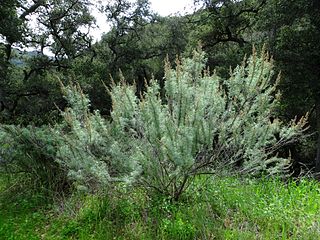
Artemisia californica, also known as California sagebrush, is a species of western North American shrub in the sunflower family.

Cercocarpus ledifolius is a North American species of mountain mahogany known by the common name curl-leaf mountain mahogany. It is widespread across much of the Western United States as well as Baja California in Mexico. It can be found at elevations ranging from 600 to 3,000 m elevation, with the preferred altitude varying depending on the region. It prefers shallow, well-drained soils with a sandy or grainy consistency, and is generally found in areas which receive low annual precipitation (15–26 cm). This makes it common on low mountains and slopes, where it grows in scattered groves among other drought-resistant species such as Pinyon Pines, Junipers and Sagebrush ecosystems.

Artemisia arbuscula is a North American species of sagebrush known by the common names little sagebrush, low sagebrush, or black sagebrush. It is native to the western United States from Washington, Oregon, and California east as far as Colorado and Wyoming. It grows in open, exposed habitat on dry, sterile soils high in rock and clay content.

Artemisia bigelovii is a North American species of sagebrush known by the common name Bigelow sagebrush or flat sagebrush. It grows in the deserts of the southwestern United States.

Artemisia rothrockii is a North American species of sagebrush known by the common names timberline sagebrush and Rothrock's sagebrush.

Artemisia spinescens is a North American species of sagebrush in the sunflower family, known by the common name budsage.
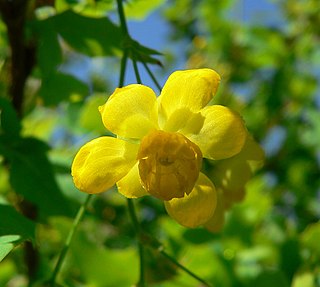
Mahonia fremontii is a species of barberry known by the common name Frémont's mahonia.

Quercus turbinella is a North American species of oak known by the common names shrub oak, turbinella oak, shrub live oak, and gray oak. It is native to Arizona, California, New Mexico, Utah, Colorado, and Nevada in the western United States. It also occurs in northern Mexico.

Artemisia cana is a species of sagebrush native to western and central North America, a member of the sunflower family. It is known by many common names, including silver sagebrush, sticky sagebrush, silver wormwood, hoary sagebrush, and dwarf sagebrush.

Symphoricarpos longiflorus is a species of flowering plant in the honeysuckle family known by the common names desert snowberry and fragrant snowberry. It is native to the western United States from the Great Basin to western Texas, as well as northwestern Mexico.
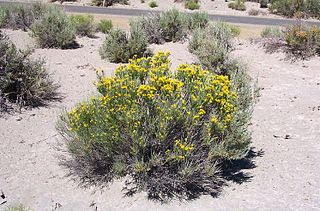
Tetradymia glabrata is a species of flowering plant in the aster family known by the common name littleleaf horsebrush. It is native to the western United States, especially the Great Basin and Mojave Desert. Its habitat includes sagebrush, woodlands, and scrub. It is an erect, bushy shrub growing to a maximum height over one meter, its stems coated unevenly in white woolly fibers with many bare strips. The narrow, pointed leaves are usually no more than a centimeter long and most occur in clusters along the branches. The inflorescence bears up to seven flower heads which are each enveloped in four woolly phyllaries. Each head contains four yellow cream flowers each around a centimeter long. The fruit is a hairy, ribbed achene with a pappus of bristles.
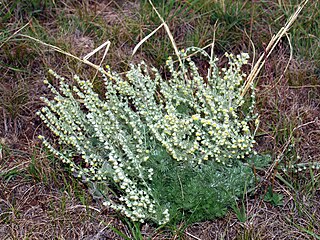
Artemisia frigida is a widespread species of flowering plant in the aster family, which is known as the sunflower family. It is native to Europe, Asia, and much of North America. In parts of the north-central and northeastern United States it is an introduced species.

Artemisia pedatifida is a species of flowering plant in the aster family known by the common names birdfoot sagebrush and matted sagewort. It is native to a section of the west-central United States encompassing parts of Idaho, Montana, Wyoming and Colorado, where it occurs on the high plains.
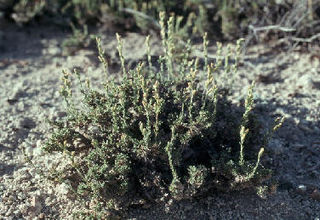
Artemisia pygmaea is a North American species of sagebrush in the aster family known by the common name pygmy sagebrush.

Artemisia rigida is a species of flowering plant in the aster family known by the common names scabland sagebrush and stiff sagebrush. It is native to the northwestern United States, in Washington, Idaho, and Oregon. It has been recorded in western Montana but these sightings may have been misidentifications.
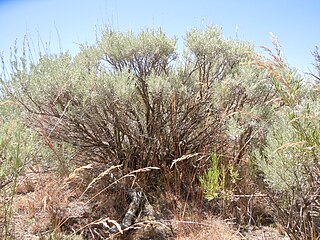
Artemisia tripartita is a species of flowering plant in the aster family known by the common name threetip sagebrush. It is native to western North America from British Columbia to Nevada and Montana to Colorado. It covers about 8.4 million acres of the Rocky Mountains and Great Basin.
Astragalus anisus is a species of flowering plant in the legume family known by the common name Gunnison milkvetch. It is endemic to Colorado in the United States, where it is limited to the Gunnison Basin of Gunnison and Saguache Counties.



















